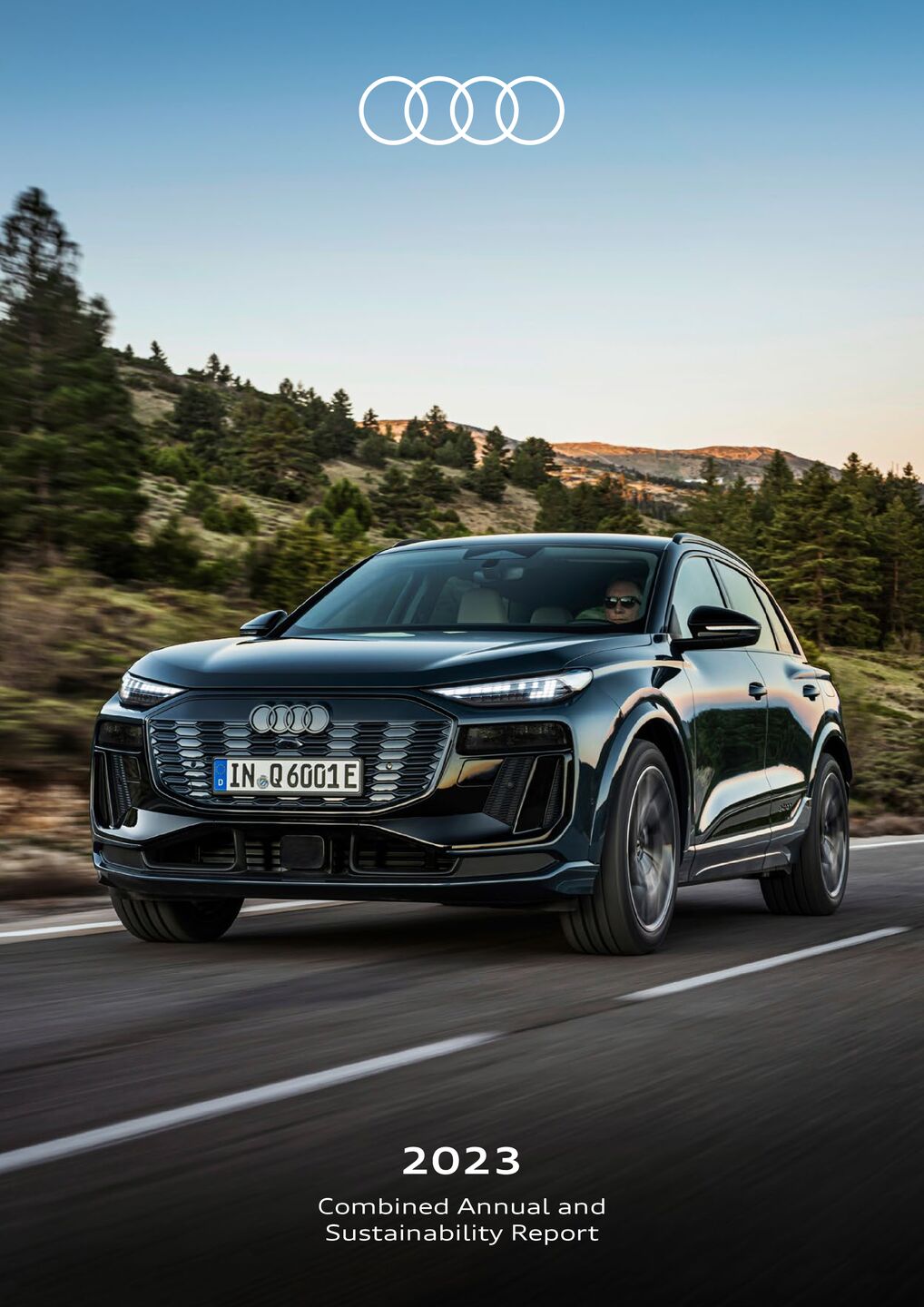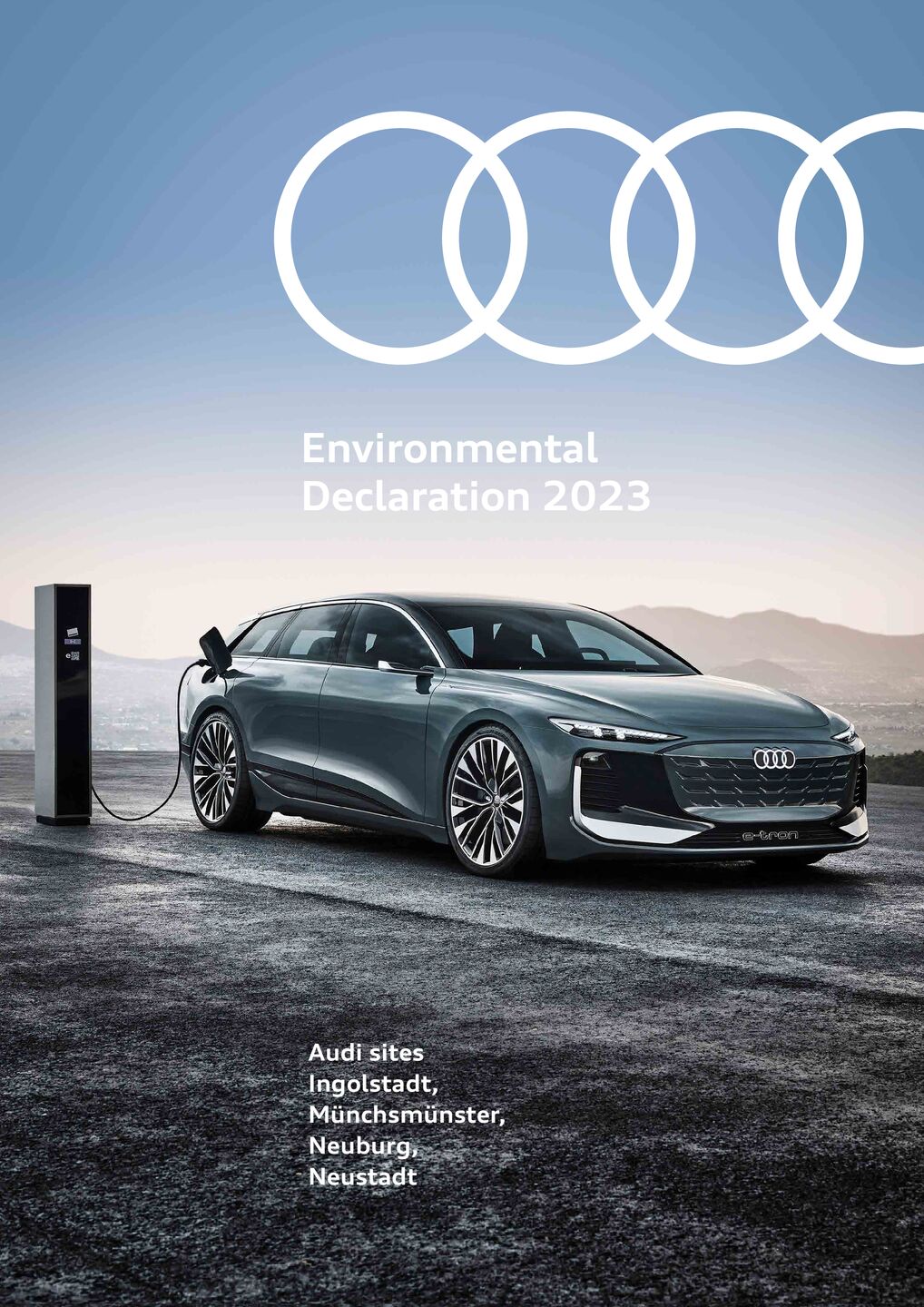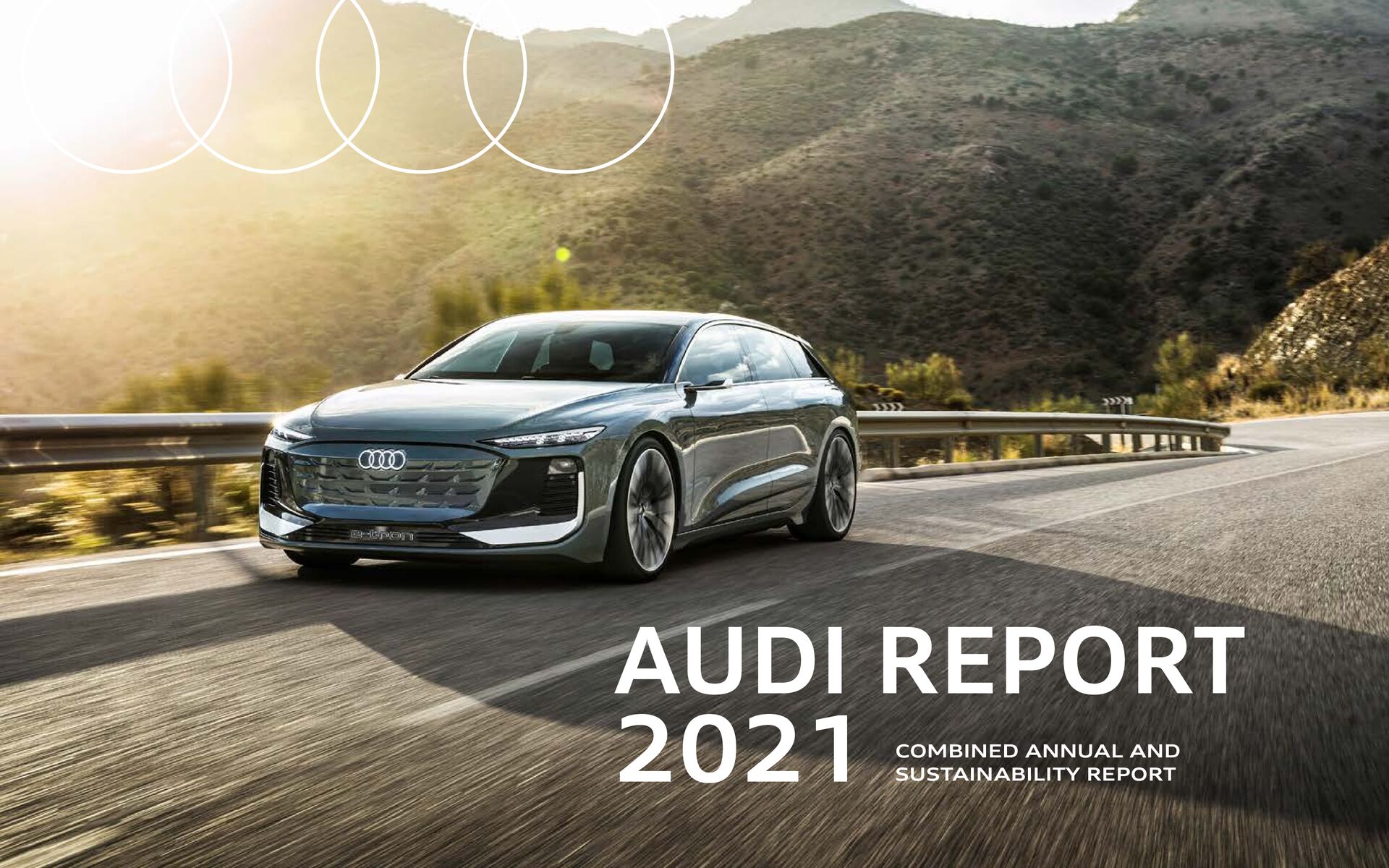Search
All results
(875)
MediaInfos
(573)
News
(39)
BasicInfos
(3)
Press kits
(1)
Biographies
(1)
Images
(23)
Videos
(7)
Publications
(37)
 2023: Combined Annual and Sustainability Report
2023: Combined Annual and Sustainability Report
The DNSH (Do No Significant Harm) criteria for economic activities define the minimum requirements which must be fulfilled in order to exclude any significant harm to any of the other environmental objectives. In the year under review, the DNSH criteria for the economic activities “Manufacture of low-carbon technologies for transport” and “Manufacture of automotive and mobility components” for the Audi Group were analyzed at the higher level of the Volkswagen Group. For the vehicle-related business, the analysis was performed at the level of the individual production sites which manufacture or will in the future manufacture Audi vehicles that fulfill the screening criteria named under step 2 above or will do so in the future in accordance with the five-year plan. The Volkswagen Group’s Annual Report presents the key interpretations and analyses used by the Volkswagen Group to examine whether any substantial harm has been done to the other environmental objectives. The result of these assessments is that the Audi Group’s vehicle-producing sites fulfilled the DNSH criteria in the year under review. 4 • No significant harm to the other environmental objectives • Central Volkswagen assessment: criteria fulfilled by Audi • Upholding human rights and meeting minimum social standards • Central Volkswagen assessment: criteria fulfilled by Audi 3 Ill us tr at io n: C 3 V is ua l L ab FinanceStrategy & Company ESG Appendix 53 Audi Report 2023 In accordance with the EU taxonomy, capital expenditure covers additions to intangible assets, property, plant and equipment, leasing and rental assets, and investment property. All capital expenditure attributable to the vehicle-related business was associated with the economic activity “Manufacture of low-carbon technologies for transport.”
 Audi Tradition - Anniversary Dates 2024
Audi Tradition - Anniversary Dates 2024
The engineers incorporated large, load-bearing aluminium panels into the bodywork cell that was created. Along with the welding and adhesive bonding technology, this was also the first time in automotive engineering that self-piercing rivets had been used as connecting elements. The Audi A8 was initially available in the quattro version with a 4.2-litre V8 engine that produced 220 kW/300 hp. Other units with six, eight and twelve cylinders were set to follow as petrol and diesel engines. Audi A8 Years 30 Audi Tradition 9 Anniversary Dates 2024 Market launch of Avant RS2 1994 was the year in which the first customers were able to pick up the high-performance estate car that had been developed in cooperation with Porsche on the basis of the Audi S2 Avant from their Audi dealer; it was first unveiled the year before at the International Motor Show in Frankfurt. Changes to the engine control unit, turbocharger and intercooler and an optimised exhaust gas system boosted the performance of the 2.2-litre five-cylinder engine up to 232 kW/315 hp. Combined with a close-ratio, six-speed manual gearbox, this guaranteed acceleration up to 100 km/h in just five seconds. The non-limited top speed was 262 km/h. The Avant RS2, which cost almost 100,000 DM, was manufactured from 1994 at Porsche in Zuffenhausen in a production alliance with the Audi factory in Ingolstadt. Over two years of production, the company manufactured 2,908 Avant RS2 instead of the 2,200 cars that were planned, reinforcing the tradition of the RS high-performance models. Years 30 Audi Tradition 10 Anniversary Dates 2024 Audi duo In autumn 1989, the third generation of the Audi 100 provided the basis for developing the “Audi duo”, which was first presented at the Geneva Motor Show in March 1990. Working in close cooperation with the Kulmbach-based company Pöhlmann, the Audi developers cut back the drive to the rear axle on an Audi 100 Avant quattro with a 98 kW/133 hp five-cylinder injection engine.
 Environmental Declaration 2023
Environmental Declaration 2023
A well-trained plant fire department that is well equipped with emergency vehicles is always on call. Thousands of signaling devices (smoke, fire, leakage of liquids) are installed in the security and control centers so that measures can be taken immediately in the event of an alarm notification. Involvement of the employees/Audi Ideas Program The basics of production and important processes are described in the Audi Production System (APS), including all key aspects of environmental protection and possibilities for saving energy. The employees can use the APS to obtain information and also take part in various training courses suitable for their function, for example as employees in manufacturing planning, as apprentices or as group leaders in Production. In addition, all employees are encouraged to offer suggestions for protecting the environment and saving energy in the Audi Ideas Program. The Audi Ideas Program: In over 20 years, employees have submitted more than 58,000 clever ideas 16 Environmental Declaration 2023 17 New high-efficiency top coat line As part of the gradual restructuring of the paint shop at the Ingolstadt site, a new top coat line is being installed that will operate largely without fossil energy consumption, significantly reduce water consumption and emissions and also meet the requirements of e-mobility. The paint shop is one of the biggest consumers of energy and resources for every car maker, which is why there is a particular focus on this area in the context of the restructuring of the top coat lines. The new top coat line pursues the major Audi goal of achieving net carbonneutral production at the Ingolstadt site by 2025. Instead of gas, which is a fossil fuel, the new drying systems for hardening the coat surface will be operated with electricity – with “green electricity” to be precise.
 Audi Report 2022
Audi Report 2022
sold exclusively in China. ¹³ Vehicle is manufactured locally by associated companies and available and sold exclusively in China. ¹⁴ The Bentley brand was consolidated effective January 1, 2022; the prior-year figure includes 61 vehicles delivered by an Audi sales company. * Information on electric power consumption and CO₂ emissions in ranges depends on the vehicle’s selected equipment.
 Anniversary Dates 2023
Anniversary Dates 2023
Just three years earlier, Audi had presented the Audi TT prototype study at the Frankfurt International Motor Show. As was already the case with the concept car and the Audi A3 which was introduced in 1996, the Audi TT was based on the transverse engine platform of the VW Golf IV. In March 1999, Europe’s biggest motoring magazine, “Auto Europe”, voted the Audi TT Europe’s number 1 car, the best new model of the year. The turbocharged four-cylinder engines with an output of 150, 180 and 225 hp were followed in the TT quattro Sport by the 250 hp V6 engine and a fourcylinder engine with its power boosted to 240 hp. In 2005, when the second-generation successor model was already about to be launched, the power of the two “small” four-cylinder engines was increased to 163 and 190 hp. By mid-2006, over almost eight years of production 178,765 Audi TT Coupés had rolled off the production line. years 25 Audi Tradition 6 Anniversary Dates 2023 On 18 February 1993, as part of AUDI AG’s new strategic focus, the company established a fully owned subsidiary based in Győr, Hungary to outsource some of its production abroad for the first time in the company’s history. The factory, which initially only manufactured engines, started operating in October 1994. By 1996, the production capacity had doubled to 1,500 units a day; in 1998 Audi Hungaria joined forces with the factory in Ingolstadt to assemble the Audi TT. The decision was made in 2010 to expand the Győr factory into a site offering full automotive production. In 2021, 11,983 employees produced over 170,000 automobiles and more than 1.6 million diesel, petrol and electronic powertrains there. Foundation of Audi Hungaria Motor Kft.30 years Audi Tradition 7 Anniversary Dates 2023 In October 1988, AUDI AG unveiled the Audi V8, which represented the company’s first foray into the premium segment.
 Audi Report 2021
Audi Report 2021
Figuratively speaking, these microprocessors are the brain of a car and handle, for example, control functions for driver assistance systems, connectivity services and infotainment functions. Current Audi models sometimes use more than 100 connected control units. These comprise several thousand semiconductors. A significant shortage of semiconductors has been leading to supply bottlenecks in industry globally since the beginning of 2021. The automotive industry has also felt the effects of this undersupply, which was triggered, among other things, by factory closures at key manufacturers as a result of the pandemic. Audi consequently also had to cut production, leading to temporary short-time work at the German sites. Product adjustments and reductions in stocks stabilize deliveries Since the beginning of 2021, Audi has been working relentlessly in company-wide crisis teams and in close collaboration with the Volkswagen Group to limit the impact of the semiconductor shortage. For instance, Audi continually adapted production to take account of installation rates, volumes or equipment variants and also manufactured vehicles that can be retrofitted at a later time. The brand satisfied the strong demand for cars optimally through increased reductions in stocks. In the medium to long term, Audi is planning to adapt the procurement strategy together with the Volkswagen Group, in part through direct access to semiconductor manufacturers or by developing its own chips to minimize the risk in the future. Nonetheless, owing to the semiconductor crisis the Audi Group was unable to produce a low six-digit number of vehicles in 2021 as planned. This also impacted the key figures for 2021. Semiconductor shortages also expected in 2022 The production of semiconductors is a complicated and protracted process. In addition, the chip manufacturers need a certain lead time to ramp up their capacity to the required levels.
 Anniversary Dates 2022
Anniversary Dates 2022
Anniversary Dates 2022 Audi Tradition Audi Tradition 2 Anniversary Dates 2022 Contents Anniversaries in Our Corporate History Autumn 1997 25 years of Audi AI 2 and A2 prototypes ....................4 September 1997 25 years since market launch of Audi S4 (B5) ...........5 1997 25 years since market launch of Audi A6 (C5) ...........6 September 1997 25th anniversary of death of Ludwig Kraus ..............7 September 1992 30 years since first Audi Avant in the B-series ...........8 Autumn 1982 40 years of third-generation Audi 100 .....................9 April 1977 45 years of five-cylinder engines at Audi ................10 August 1977 45 years since first Audi 100 Avant (C2) .................11 1972 50 years since first Audi 80 (B1) ............................12 August 1972 50 years since Dr. Piëch joined Audi .......................13 September 1967 55 years since unveiling of NSU Ro 80 ...................14 September 1957 65 years since NSU resumed car manufacturing .....15 February 1957 65 years since first NSU rotary piston engine .........16 June 1932 90 years since founding of Auto Union AG ..............17 June 1922 100 years of DKW motorcycle manufacturing ........18 June 1922 100 years since Dr.
 &Audi SocAIty study
&Audi SocAIty study
Conversely, when the same vehicle joins the highway or enters an urban area, Levels 3–5 could be automatically activated or a higher level of automation suggested. Geofencing, the technology to delineate these different zones, already exists and is even being used in other areas. An Era of (Partially) Autonomous Mixed Traffic By 2030, mobility will already entail a new type of mixed traffic with both autonomous and humandriven vehicles on the road. The extent to which this mixed traffic will actually be a widespread reality largely depends on whether and how well autonomous systems are able to react to irrational human behavior in their current form. Many of the experts interviewed agreed it is quite conceivable that there will also be areas, including for individual passenger transport, where only Level 4 or 5 vehicles will be allowed to drive. The Operational Design Domain (ODD) will play a key role here. This domain sets out the requirements or conditions under which an autonomous driving system can function safely and reliably. The better and more clearly factors such as infrastructure, environment, weather influences and road conditions can be defined and predicted, the higher the level of automation can be. “Infrastructure plays a vital role. Just think of the grid street plans and long highways in the US. From a manufacturer’s point of view, it’s much easier to find solutions there than in the winding old-town streets of European cities.” Tobias Miethaner “I believe we could see extensive global robo-taxi operations in cities by around 2035–2040 if we hedge on 1 critical error per 1 billion kilometers. With strong technological progress every four years, we could even see this not long after 2030.”